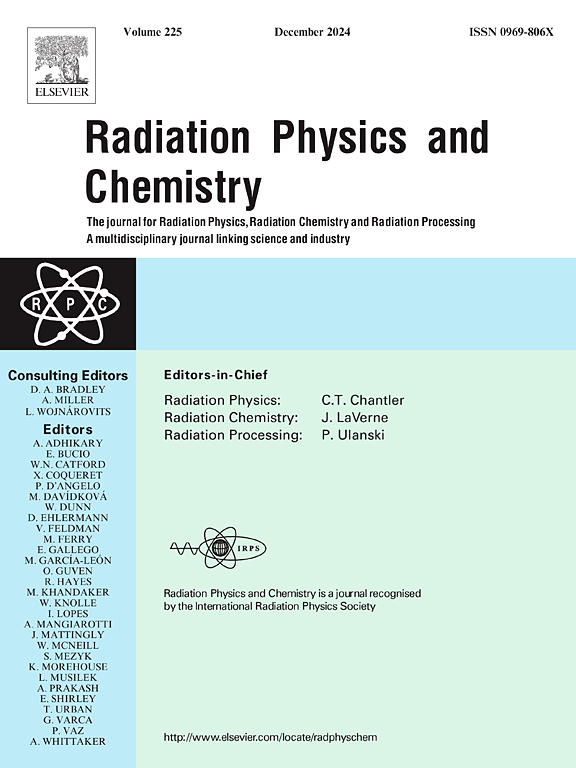利用 LaBr3(Ce)探测器进行硬 X 射线光谱分析以研究泰国托卡马克 1 号失控电子的初步结果
IF 2.8
3区 物理与天体物理
Q3 CHEMISTRY, PHYSICAL
引用次数: 0
摘要
泰国托卡马克 1 号(TT-1)于 2023 年初成功实现了首次等离子体运行。由于等离子体放电过程中的高能失控电子(RE)可能会对舱内组件造成重大损害,因此了解等离子体放电过程中的RE行为对TT-1来说至关重要。为了研究失控电子的行为并分析其特征,我们采用了 LaBr3(Ce) 探测器来测量 TT-1 中的硬 X 射线辐射。在这项研究中,我们首先在实验室对 LaBr3(Ce) 探测器进行了鉴定,然后在 TT-1 中进行了硬 X 射线光谱分析。在实验室中使用了能量高达 1.33 MeV 的校准源,包括 133Ba、137Cs、22Na 和 60Co。探测器使用偏压为 -1000 V 的高压进行校准,发现在能量为 0.662 MeV 时,能量分辨率约为 6.2%。校准后,探测器被安装在 TT-1 上测量硬 X 射线。我们分析了 2183 号放电装置在选定时间间隔内发射的硬 X 射线。结果发现,高能硬 X 射线辐射高达约 500 keV。假设 RE 群体呈简单的 Maxwellian 分布,其温度估计为 224±5 keV。这些发现证实了 TT-1 等离子体放电过程中存在高能失控电子。然而,要从硬 X 射线能谱中准确推导出失控电子能谱,还需要展开技术。在今后的工作中,我们计划应用展开方法,对失控电子的物理现象进行数值模拟,并对硬 X 射线发射进行蒙特卡罗模拟。本文章由计算机程序翻译,如有差异,请以英文原文为准。
Initial results of hard X-ray spectroscopy by LaBr3(Ce) detector for runaway electron study in Thailand Tokamak-1
Thailand Tokamak-1 (TT-1) successfully achieved its first plasma operation in early 2023. Understanding the behavior of high-energy runaway electrons (RE) during plasma discharges is crucial in TT-1 due to the potential risk of significant damage to in-vessel components. To study the RE behavior and analyze its characteristics, the LaBr(Ce) detector was employed for measuring hard X-ray emissions in TT-1. In this study, we first characterized the LaBr(Ce) detector in the laboratory and then performed hard X-ray spectroscopy in TT-1. Calibration sources, including 133Ba, 137Cs, 22Na, and 60Co, with energies up to 1.33 MeV, were used in the laboratory. The detector was calibrated using biased high voltage of -1000 V. It was found to have an energy resolution of approximately 6.2% at an energy of 0.662 MeV. After calibration, the detector was installed at TT-1 to measure hard X-ray. We analyze the hard X-ray emission from discharge #2183 during a selected time interval. It is found that the high-energy hard X-ray emissions reach up to approximately 500 keV. Assuming a simple Maxwellian distribution of the RE population, their temperature is estimated to be keV. These findings confirm the presence of high-energy runaway electrons during TT-1’s plasma discharges. However, to accurately derive the runaway electron energy spectrum from the hard X-ray energy spectrum, the unfolding technique is required. In future work, we plan to apply the unfolding method, conduct numerical simulations on the physics of runaway electrons, and employ Monte Carlo simulations on the hard X-ray emissions.
求助全文
通过发布文献求助,成功后即可免费获取论文全文。
去求助
来源期刊

Radiation Physics and Chemistry
化学-核科学技术
CiteScore
5.60
自引率
17.20%
发文量
574
审稿时长
12 weeks
期刊介绍:
Radiation Physics and Chemistry is a multidisciplinary journal that provides a medium for publication of substantial and original papers, reviews, and short communications which focus on research and developments involving ionizing radiation in radiation physics, radiation chemistry and radiation processing.
The journal aims to publish papers with significance to an international audience, containing substantial novelty and scientific impact. The Editors reserve the rights to reject, with or without external review, papers that do not meet these criteria. This could include papers that are very similar to previous publications, only with changed target substrates, employed materials, analyzed sites and experimental methods, report results without presenting new insights and/or hypothesis testing, or do not focus on the radiation effects.
 求助内容:
求助内容: 应助结果提醒方式:
应助结果提醒方式:


